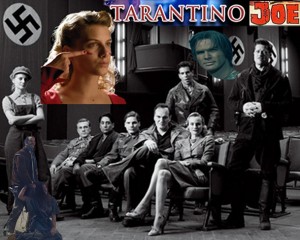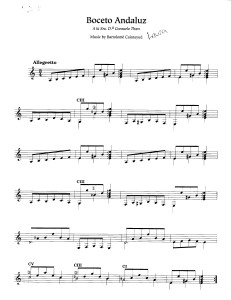Quentin Tarantino’s Inglourious Basterds is Essentially a Spaghetti Western.
By Marc Frucht
Will we ever tire of consuming Spaghetti Westerns, and what does this do to the people of the Native American nations?
!
This essay will show that the 1966 spaghetti western Navajo Joe has been copied and “cannibalized†all throughout its history including last year and the year before with Inglourious Basterds and Rez Bomb respectively.
Navajo Joe and Inglourious Basterds have so many similarities but I’ll just list a few.
Navajo Joe opens with this scene: a young Indian woman Estella cleans cloths at the wash of a small canyon. Inglourious starts off in Nazi occupied France with a farmer named Perrier LaPadite using an axe, while his teenage daughter Julie is hanging laundry on a clothesline. She is the first to see the Nazis. Do all indigenous girls engage in the drudgery of cloths cleaning while oppressed by occupying forces of other nations?
Brad Pitt’s character goes around killing everyone in sight like Dirty Harry or Terminator; and so does Bert Reynolds as Navajo Joe. Where Navajo Joe carves double triangles into people’s faces and foreheads, Pitt’s Lt. Aldo Raine often carves swastikas into foreheads.
These dances are done to music, by the way, scored by the same man in both films: Ennio Morricone. His work also shows in such movies as The Good, the Bad and the Ugly (1966) and Once Upon a Time in the West (1968). If you watch any western, most notably a spaghetti western, there is a good chance if they didn’t use his work, there will be songs throughout that sound quite derivative of such. Nevertheless, Quentin Tarantino hired the same man to score his movie about Jews rising up against Hitler, that Sergio Corbucci had tapped for Navajo Joe.
“Algiers,” “Mystic and Severe,” and “The Verdict” are just a few Morricone songs used in Inglourious. There are many more of his own songs as well as a David Bowie tune and some Billy Preston which Morricone surely helped find appropriate places to position all these songs.
“Cat People†by David Bowie is a rather creepy song with the lyrics “putting out fire with gasoline.” Many things blow up throughout the Tarantino movie, but not so much with Corbucci’s film. Both do share the feeling of the protagonists killing people rapid fire, sustained over time.
Women are treated somewhat similarly in both movies; I’ll touch on that briefly.
The French Farmer’s daughters helping their dad, reminds me of women in Navajo Joe having mostly a helpful role. But I will say that Shoshana’s role is quite empowered, as is the movie star Bridget von Hammersmark. Neither simply hands weapons to their men just hoping they’ll go save everyone. It’s not clear how much of that is from Tarantino just liking to have EVERYONE shooting everyone else, or how much is historically accurate to 1940s Germany and France. I know when I saw one of the women load up a small handgun and place it in their purse I was reminded of an interview someone did with Greta Garbo long after Hitler had killed himself in his bunker, where she said that during her private lunch with the Fuhrer, the thought never occurred to her to shoot him because she was apolitical at the time. He was leader of a nation, and she was a Swedish American film star he wanted to wine and dine. She had a loaded derringer in her purse the whole time but never thought of popping a round into the old sicko.
Mervyn ‘Vee’ Duncan is a “half-breed†enemy leader in Navajo, while early in Inglourious Landa says to the French farmer, “I can think like a Jew, where they can only think like a German.” He’s bragging that his skills make him better than most German soldiers. I believe he is strongly implying that he’s part Jewish like Hitler himself was known to be. Hitler was said to have had a Jewish grandfather who he hated very much. So Landa (Hitler as well) just might be mixed like Duncan.
One last thing might help in correlating the triangles and the swastika. Hitler stole and misappropriated that symbol from the Hopi. Two Swastikas represent two halves of the Earth. From each of the poles (or anywhere for that matter) you have people take off to the four directions and then change direction to the left or a right, depending on which swastika you are walking. Together the two symbols represent Earth in perfect balance. By appropriating just one of them Hitler set the world into imbalance. He stole that symbol, which perversely corrupted it; but he also used the symbol of the pink triangle to represent gay people. At the same time he was making Jews wear the yellow Star of David on their clothing at all times, he was making gay people wear pink triangles.
Tarantino portraying the Jewish Americans rising up against Hitler in such a fantastical way is quite similar to Italians and Germans portraying Indians rising up against the oppressive Spanish and English settlers. Perhaps it is a much classier and more respectful version of a spaghetti western!
Author Edward Buscombe says that the American West is mostly a European invention. In his book ‘injuns!’ native Americans in the movies he says if Europeans had not “already been gripped by a fantasy about the West, one that drew them across the ocean and into unexplored lands, then the western part of North America might never have become part of the United States.†(181)
If Europeans were ever going to transcend bad portrayals of Indian people, families, nations and cultures it would have to happen despite America’s film industry, because they weren’t much help it seems. Jacquelyn Kilpatrick says as much about everyone from John Wayne to John Ford in her book CELLULOID INDIANS: Native Americans and Film. “Regrettably, because he is John Wayne,†she says, “because he is so untiringly skillful in the pursuit, his motivation dominates in building audience attitude.†(Kilpatrick, 61)
She calls it unfortunate that Wayne’s character is acting “according to the mores of the day.†(Kilpatrick, 61) She’d begun the book suggesting that unlike Ford and Wayne, Gary Cooper’s depiction of Indians is positive overall, while at the same time pointing out he was criticized years later for “romanticizing the Indian.†(Kilpatrick, 4) Isn’t this the same issue commonly held with any person portrayed as “other?†The current U.S. President, Barack Obama is considered too black one moment, too white another. People complain he’s too rich; others will complain he’s too poor, too aggressive or not demonstrative enough. This certainly happens to Indians as much as it does to Africans. This whole portraying someone as “other†while at the same time as “just not right†somehow, fits right in alongside dividing and conquering really.
Ward Churchill says he believes “that cinema, by concentrating solely upon a narrow period of time in Indian history†denies the present-day realities of Indian existence. (Buscombe,17-18) Doesn’t Tarantino do much the same by saying nothing about Jewish culture before or after Hitler? Buscombe says westerns’ plots are always “formulaic but complicated, with characters endlessly captured, then rescued, then captured again.†He says there’s a “pretty girl, usually assigned to a young suitor, not to the heroes.†(Buscombe,205) Doesn’t this fit for all westerns? It certainly illuminates Inglourious Basterds a bit too.
HOLLYWOOD’S INDIAN: The Portrayal of The Native American In Film says reading spaghetti westerns as metaphors “does not mean that this articulation was always conscious – nor that they would have been perceived as such metaphors by the public. Nonetheless, we may still presume that these westerns played a specific role, in the construction of… national identity.†(Rollins,41)
Something tells me America’s love of a movie like Inglourious serves to further reinforce her need to defend Israel against all comers, beginning with Hitler, much the same (or equally opposite) way Italy and East Germany wanted the Indians to rise up and destroy capitalist America.
Where it seems like Tarantino might have merely reset Indians as Jews and the Anglo settlers as Hitler’s Nazis; maybe Steven L. Simpson’s Rez Bomb serves as a more classical rewrite of a traditional spaghetti western. Two of the many characteristics which signify spaghetti westerns quite easily are location choices and outsider viewpoints.
When Scott catches a ride quickly while hitchhikes by standing right between two different Indian families, his acting is a very effective tool for showing the racism on the reservation, as are comments from others saying if Jaws killed a white guy things would be different than with so many other people “found lying face down stuck in a ditch somewhere.” But to say it’s identical to some of the scenes in Navajo Joe might be a bit of a stretch. That might be easier to compare with the portrayals of Nazis and Jews in Inglourious. I feel Rez Bomb could have gone into each of those issues with even more of a deeper treatment. Russell Means’ portrayal of the character Dodds shows he’s corrupt but doesn’t even imply why, or for how long. Is he much like Duncan in Navajo Joe, or is he more like one of Dickey Wilson’s 1970s Goons (Guardians Of Oglala Nation) maybe?
Many of the westerns that got the nickname “spaghetti†were filmed in places like East Germany and Italy because that was a whole lot less money than in John Ford’s favorite locations like Monument Valley. Along similar lines, Simpson chose Pine Ridge saying publicly that he was bringing economic development to the community. It might also have a lot to do with the notion that you can feed a family of four at Taco Johns or the Chinese buffet there for less than twenty dollars. Now, Navajo Joe and Rez Bomb are produced by people who are definitely not Indian, Simpson is from Scotland living in Hollywood as an ex-patriot and of course Corbucci is every bit as Italian as his name. Conversely similar is that Quentin Tarantino is neither German nor Jewish, rather he tells people he’s Italian American and Irish Cherokee (there’s some irony right there) and is said to have had a fascination with spaghetti westerns while growing up. An additional irony might be that people in Wikipedia and Imdb.com often complain saying his earliest films used nonlinear storylines. Perhaps his “outside the box†perspectives and eye for the nonlinear come from his part Cherokee mother who raised him. Or certainly someone else on that side of the family.
Lastly, when Landa switched to English, he was using that language as a weapon against the Jewish family he was hunting. He knows they don’t speak the language at all, but the two of them do. Wow. I wonder how often that kind of tactic was actually being used by Hitler’s people? And is there any parallel or corollary to Americans using Navajo and Comanche languages for important radio communications during WWII.
When Aldo looks over his carving on Landa’s forehead and tells his buddy “You know somethin’, Utivich? I think this just might be my masterpiece,” it might also be Tarantino saying this to us! Whether Inglourious Basterds was a masterpiece, may be debated for some time now; but it might be Tarantino’s best work to date; and it’s definitely the best remake of a spaghetti western I’ve ever watched.
ÂWorks Cited:
Buscombe, Edward. ‘injuns!’ native americans in the movies. Cornwall: Reaktion Books, 2006.
Inglourious Basterds. Dir. Quentin Tarantino. Perf. Brad Pitt Mike Myers Melanie Laurent. DVD. The Weinstein Company, 2009.
Kilpatrick, Jacquelyn. CELLULOID INDIANS: Native Americans and Film. Lincoln: University Of Nebraska Press, 1999.
Navajo Joe. Dir. Sergio Corbucci. Perf. Burt Reynolds Aldo Sambrell Fernando Rey Peter Cross. DVD. Shock, 1966.
Rez Bomb. Dir. Steven L. Simpson. Perf. Moses Brings Plenty Tamara Feldman Tokala Clifford. DVD. Roaring Fire Films, 2008.
Rollins, Peter C. HOLLYWOOD’S INDIAN: The Portrayal of The Native American In Film. Ed. John E. O’Connor. Lexington: University Press Of Kentucky, 2003.


